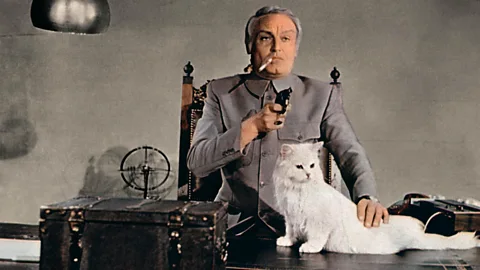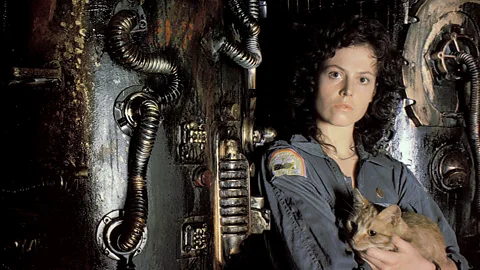Why cats are really man’s best friend – in film, at least
 Alamy
AlamyTom Hooper’s much-discussed big-screen adaptation of musical Cats finally premieres this week. Let’s just hope it adds to the noble record of kitties in cinema, says Hannah Strong.
As a rag-tag bunch of jazz-loving felines observed back in Disney’s 1970 classic The Aristocats, “everybody wants to be a cat”. Certainly that seems to be the case in Tom Hooper’s Cats, his adaptation of Andrew Lloyd Webber’s musical which features the likes of Taylor Swift, Dame Judi Dench, James Corden, Idris Elba and Sir Ian McKellen donning whiskers and so-called ‘digital fur technology’ to gleefully leap around and sing about the joys of feline frolicking.
More like this
While the world will finally bear witness to Hooper’s vision from Friday, it’s worth ing that our collective fascination with cats at the cinema has existed for quite some time. Although dogs are frequently regarded as man’s best friend, perhaps, in film at least, it’s time to make the case for kitties – who might not earn top billing, but always find a way to pull focus.
 Alamy
AlamyAfter all, long before the internet gave birth to viral animal videos and the concept of lolcats, filmmakers were capitalising on the inherent appeal of felines on screen. One of the earliest known short films, produced by Thomas Edison’s pioneering New Jersey film studio in July 1894, is entitled Professor Welton's Boxing Cats and shows two understandably unamused kittens in harnesses that keep them upright, wearing boxing gloves as they square off in a small ring. A few years later, British screen pioneer G A Smith had a similar, slightly more nuanced idea, and filmed The Sick Kitten – a sweet clip in which two young children tend to their purring patient by providing it with a spoonful of ‘medicine’ (or milk, as is more likely).
Feline-favouring filmmakers
As filmmaking began to evolve in the post-war period, so too did its portrayal of cats, with French director Jean Vigo’s pioneering 1934 film L’Atalante showing off a sea-faring group of felines belonging to Michel Simon’s eccentric bargeman Père Jules. In one scene, a kitten clings to his shoulder as Père dances on the end of the pier wildly, while playing his accordion to welcome newlyweds Jean and Juliette to his boat.
Vigo was a precursor to the French New Wave directors and fellow cat lovers Agnès Varda and Chris Marker, who would frequently feature felines in their work. While in Blake Edwards’ 1961 romantic classic Breakfast at Tiffany’s, Holly Golightly has the “poor slob” known only as Cat for company, Cléo Victoire in Varda’s Cléo from 5 to 7 (1962) lives in a plush apartment with an assortment of free-roaming kittens, evoking the image of free-spirited actress Sylvia in Federico Fellini’s La Dolce Vita (1960), cavorting with a tiny white kitten near the Trevi fountain in Rome. These lonely, creative souls find companionship in the form of their feline friends – not quite as needy as dogs, but infinitely less judgemental than humans.
Perhaps cats’ quiet sense of loyalty is why James Bond’s arch-nemesis Ernst Blofeld opts for a mog rather than an attack dog. In 1963’s From Russia With Love, before audiences even glimpse the villain himself, they are introduced to his beautiful silver-white companion, who sits nonplussed in Blofeld’s lap while plans for Bond’s demise are discussed. In a strikingly similar moment of cat-themed nefariousness, throughout the most famous scene in Francis Ford Coppola’s The Godfather, Don Vito Corleone is stroking a tabby cat perched on his knee. Both images juxtapose softness with unmistakable evil. With friends like those, who needs enemies?
 Alamy
AlamyOf course, cats have been associated with nefariousness for centuries, particularly in western culture. During the middle ages, a ‘satanic panic’ meant cats became associated with the devil, and many were killed off (inadvertently boosting the rat population, and further spreading the bubonic plague). Even after the plague, the association between cats and the supernatural endured into the 16th Century, with cats believed to be the companions of witches – William Shakespeare himself helped to spread that rumour when he created Graymalkin, the feline companion of his witches three in Macbeth. It’s no surprise, then, that cats frequently find themselves positioned as the bad guys.
Cats with superpowers
The playful anti-cat agenda in film began as early as 1934, when Edgar G Ulmer’s adaptation of Edgar Allen Poe’s The Black Cat positioned them as the familiars of supernatural entities, complicit in all manner of witchcraft and wizardry. While the suggestion of cats as otherworldly is centuries old, filmmaking has turned it into an art form, with nefarious cats popping up in Richard Quine’s Bell, Book and Candle, Jacques Tourneur’s Night of the Demon, and – most delightfully of all – Nobuhiko Obayashi’s utterly bizarre 1977 Japanese horror, House.
But perhaps a pet with superpowers isn’t such a bad thing after all. Certainly, in Mick Garris’s schlocky Steven King-penned horror Sleepwalkers, teen heroine Tanya Robertson reaps the benefits when her fearless cat Clovis brings together his feline friends to save his mistress from a vampiric hoard. Similarly, the very first animated cat on film – the Cheshire Cat in Disney’s 1951 take on Alice in Wonderland – might seem to please himself, but ultimately proves an essential guide for the young heroine thrust into a world where nothing is as it seems. Meanwhile, trading the occult for the extra-terrestrial, Ellen Ripley would have not survived the events of the Nostromo in Ridley Scott’s Alien were it not for the ship’s cat, who stares down a xenomorph with little more than a growl and a hiss, faring better than the rest of their crew.
So, a cat’s bravery cannot be understated, and they are more than capable of demonstrating loyalty – but their affections must be carefully earned. This is something all too apparent to Detective Phillip Marlowe in Robert Altman’s 1973 neo-noir The Long Goodbye. His finicky feline is outraged when Marlowe brings home a different brand of cat food, and promptly disappears without a trace – though given the chaos that quickly ensues, perhaps the cat just has the good sense to get out at the first hint of trouble.
It’s a similar story in the Coen Brothers’ 2013 drama Inside Llewyn Davis, in which down-on-his-luck folk singer Llewyn finds himself catsitting a rather splendid ginger cat named Ulysses after he escapes from the apartment where Llewyn had been staying. The cat is a comfort, as lost and despondent as Llewyn himself, though perhaps also teaches the musician some harsh life lessons – he spends much of the film either searching for Ulysses or trying to reunite him with his owner, but seems to feel some sense of sadness when eventually he succeeds. Ulysses returns to the Gorfmans; Llewyn Davis is alone again. Nothing is permanent; not Llewyn’s precarious career, nor his tentative friendship with someone else’s pet. Cats are realists, but they’re also fiercely independent, and their company is rewarding precisely because it often feels so hard-won. (Read about why we think cats are unfriendly here).
 Alamy
AlamyBut it would be remiss to assume that cats are so self-serious. In Ceyda Tuhrun’s Turkish documentary Kedi, Istanbul’s playful street cats take centre stage, their behaviour scrutinised by affectionate onlookers. “She’s the neighbourhood psychopath,” they chuckle of black-and-white cat Psikopat, while the yowling of two cats going toe-to-toe on a street corner seems inherently ridiculous; shedding their dignified posture, the cats of Kedi become natural clowns, with distinct personalities and traits, who unequivocally enrich the lives of the locals who know them best.
The expressive nature of a dog’s eyes and their often-unwavering loyalty to their masters have long made them natural favourites for our affections, whereas the history of cats on screen is a history of the deal we lowly humans have struck with them over thousands of years. In François Truffaut’s Day for Night, when a kitten refuses to act for the team attempting to film him, it is amusing because it’s such a poignant summation of our precarious relationship with these inscrutable creatures. Their friendship is an agreement; a deal forged on what we can provide them as much as they can provide us, be that love, or loyalty, or amusement, or supernatural protection in the face of danger. They have fascinated filmmakers and audiences for decades, not for their ability to act or to gamely sit for a scene, but for the exact opposite: as agents of chaos, our feline friends delight in reminding us who’s really in charge, and their unpredictable nature keeps us from complacency.
A dog might be consistent, but as Robert De Niro explains in the cat-based comedy Meet the Parents, “Cats make you work for their affection. They don't sell out the way dogs do.” This, in turn, makes their affection and attention all the more rewarding. They are terminally confounding, bringing unmistakable, unique moggy magic into our everyday lives. Let’s just hope Tom Hooper’s musical can capture a sense of this feline ferocity, and make believers out of the cat cynics once and for all.
Love film? BBC Culture Film Club on Facebook, a community for film fanatics all over the world.
If you would like to comment on this story or anything else you have seen on BBC Culture, head over to our Facebook page or message us on Twitter.
And if you liked this story, sign up for the weekly bbc.com features newsletter, called The Essential List. A handpicked selection of stories from BBC Future, Culture, Worklife and Travel, delivered to your inbox every Friday.
